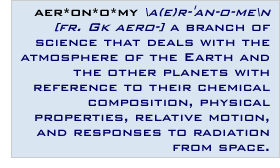 The NOAA Aeronomy Laboratory was formed in the 1960s to conduct scientific research on the Earth's atmosphere in an effort to better understand and predict its behavior. That perhaps unfamiliar name — "aeronomy" — has Greek origins and means "the study of the atmospheres of planets." The Aeronomy Laboratory focus is, of course, on Planet Earth. Specifically, the Aeronomy Laboratory's mission has been the study of the chemical, radiative and dynamical processes of the Earth's atmosphere, in order to improve the ability to predict its behavior. Today, the Aeronomy Laboratory's research focuses on the following three atmospheric issues:
The NOAA Aeronomy Laboratory was formed in the 1960s to conduct scientific research on the Earth's atmosphere in an effort to better understand and predict its behavior. That perhaps unfamiliar name — "aeronomy" — has Greek origins and means "the study of the atmospheres of planets." The Aeronomy Laboratory focus is, of course, on Planet Earth. Specifically, the Aeronomy Laboratory's mission has been the study of the chemical, radiative and dynamical processes of the Earth's atmosphere, in order to improve the ability to predict its behavior. Today, the Aeronomy Laboratory's research focuses on the following three atmospheric issues:
- Climate Change: Chemical Composition, Radiation, and Clouds
- Regional Air Chemistry
- Stratospheric Ozone-Layer Recovery
For all three areas, one hallmark of the Aeronomy Laboratory is its overarching efforts to relate scientific findings to the information needs of decisionmakers, via leadership and participation in state-of-understanding assessment reports on the topics. Approximately 110 scientists, engineers, computer specialists, postdoctoral and student researchers and administrative support staff are engaged in these endeavors at the David Skaggs Research Center in Boulder, Colorado.
Understanding Atmospheric Processes:
Answering the "How?" and "Why?" Questions
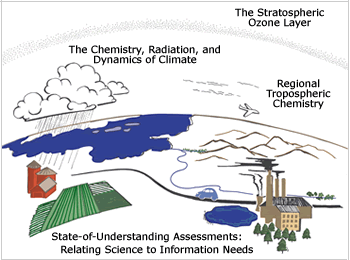
On the broadest level, the Aeronomy Laboratory's focus on the atmospheric sciences is intended to advance the scientific understanding of atmospheric processes, with the aim of enhancing the capability to observe, understand and predict the behavior of the atmosphere. The chemical, radiative and dynamical processes of the atmosphere are the gears, belts and pulleys of atmospheric change. As such, their identification and characterization are necessary for understanding and predicting the behavior of regional and global phenomena, which is at the heart of NOAA's mission.
From 1965 to Present: Providing a Scientific Information Service for National and International Decisionmakers
Although the specific scientific issues addressed by the Aeronomy Laboratory's research have evolved over the years, its guiding principle has remained steadfast — to meet the nation's most-pressing needs for scientific information about the atmosphere and its relation to the activities of humankind.
An Early Focus on the Upper Atmosphere — Chemistry and Radio Waves: In response to the nation's need for scientific information to advance radio communications and matters of national security, the Aeronomy Laboratory initially focused on the chemistry and motions of the upper atmosphere's ionosphere. For more than a decade, the Aeronomy Laboratory provided national and international scientific leadership in the field of ion-molecule chemistry, a process that governs the transmission of radio waves in the upper atmosphere. The information served two major customers: the National military and security sector, and the national and global telecommunications industry. Over a relatively short period of time in the 1960s and 1970s, the Aeronomy Laboratory scientists and their colleagues succeeded in characterizing the major aspects of the chemistry of the ionosphere. Atmospheric understanding thus "caught up" with emerging new technological capabilities, thereby meeting a critical national need.
Meeting New National Needs for Middle and Lower Atmospheric Information — Our Ozone-layer Shield: In the 1970s, when stratospheric ozone depletion and acidic deposition emerged as high priority national environmental issues, the Aeronomy Laboratory's research shifted in that direction. The focus therefore became the chemistry of the lowest two layers of the atmosphere: the troposphere and stratosphere. The laboratory again provided scientific leadership in this area, ultimately conducting the research that led to discovering that the cause of the Antarctic ozone hole was human-produced chlorine-containing and bromine-containing substances (as opposed to other hypothesized causes, such as solar activity). The information was provided to the nations that are parties to the United Nations' international agreement (the Montreal Protocol on Substances that Deplete the Ozone Layer) and contributed to the decision of those nations to strengthen provisions for the protection of the ozone layer.
Today's Priorities — Climate and Air Quality: Over the last decade, the Aeronomy Laboratory's research has shifted its focus to the chemical processes that control the characteristics of greenhouse gases and aerosols (airborne fine particles) in the lower atmosphere and surface-level ozone pollution. Climate and air quality are two topics that are a high priority for decisionmakers at all levels (private sector, state, national and international). Once again, the Aeronomy Laboratory's scientific research builds the firm foundation for their decisions. One example of how the Aeronomy Laboratory assists decision makers today is by identifying unexpected factors that cause a region's particular air pollution episodes — information that enables state agencies to develop the most effective and most economical approaches to improving air quality.
This brief history clearly illustrates that the Aeronomy Laboratory's scientific direction is dynamic, not static. As new scientific questions arise (that are consistent with NOAA's mission and planning), the laboratory changes direction to address those issues — thereby significantly contributing to national scientific needs.
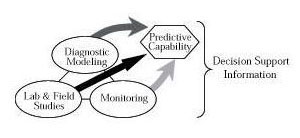
Aeronomy Laboratory Research Approaches:
Integration and Synergies
The Aeronomy Laboratory's research involves the integration of the following three approaches:
- Investigations under controlled conditions in the laboratory
- Field measurements in a variety of environments (both in campaign mode and via regular observations)
- Regional and global theoretical/diagnostic analyses
A hallmark of the Aeronomy Laboratory is the integration of these thre endeavors to build a better predictive understanding. Specifically, the investigations in the laboratory characterize properties of chemical reactions, which are used both in predictive models and as a test bed for the development of new analytical techniques. Field campaigns provide the observations to test the predictive capabilities of models, as well as unknown processes that should be examined in the laboratory. Diagnostic models, via sensitivity studies, evaluate the impact of processes on the global picture, investigate which chemical processes would have the biggest payoff for laboratory investigations, as well as help guide the design of regional or global field campaigns.
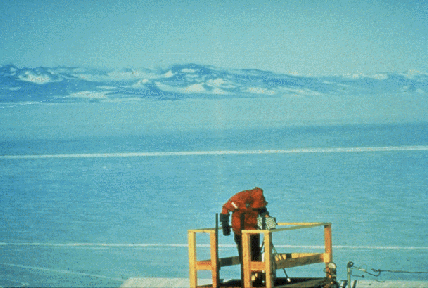
Accomplishments
Awards and Recognition: Over the years, the accomplishments of Aeronomy Laboratory scientists have been recognized within NOAA, by the nation and on the international level. Its scientists have received the NOAA Administrator's Award, the Department of Commerce Gold Medal, the Presidential Rank Award, the National Medal of Science, membership in the National Academy of Sciences and awards from the United Nations Environment Programme.
Service as Leaders: Aeronomy Laboratory scientists have been asked to serve in scientific leadership roles, such as chairmanship of the Science Working Group of the Intergovernmental Panel on Climate Change, the Scientific Assessment Panel of the United Nations Montreal Protocol on the ozone layer and the Air Quality Research Subcommittee of the administration's Committee on Environment and Natural Resources. Aeronomy Laboratory scientists have also been asked to serve in leadership positions on special-focus committees of professional societies (such as the American Meteorological Society and the National Academy of Sciences-National Research Council) and on scientific steering committees of international research programs (e.g., the World Climate Research Programme's Stratospheric Processes and Their Role in Climate (SPARC) project and the International Global Atmospheric Chemistry Project).
Signature accomplishments of the Aeronomy Laboratory include:
Characterization of the chemistry of the Earth's upper atmosphere, thus enabling a new age in the understanding and prediction of communications and in matters of national security;
Discovery of the cause of the Antarctic ozone hole, and the communication of that information to world governments to underpin their decisions regarding protection of the ozone layer;
Discovery of the capability of Doppler radar profilers to determine atmospheric wind profiles, a technology that now is a key element of the suite of weather observations that underlie NOAA's weather forecasts;
Identification of the relative roles of natural and human-produced compounds in the production of tropospheric ozone pollution, information that has helped state agencies to develop more effective and less expensive air quality improvement measures that avoid costly overregulation; and
Ongoing since the 1980s, extensive roles in leading, authoring, reviewing, editing and/or publishing international scientific state-of-understanding assessments on three topics: the climate system, pollutant ozone and fine particles, and the stratospheric ozone layer. These information products provide key scientific input to pending national and international decisions regarding these three important issues.
Recent Aeronomy Laboratory accomplishments include the following:
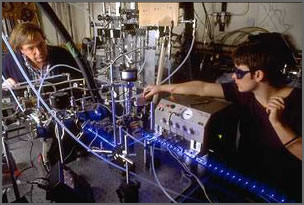
Used a new instrument developed at the Aeronomy Laboratory to obtain the first chemical "fingerprint" of the individual aerosol particles that are effective in causing cloud formation. PAYOFF: By identifying the chemical makeup of the less than 1 percent of ambient particles that are effective cloud condensation nuclei, this research will improve the capabilities of NOAA's Climate Services Program to predict cloud formation, thereby enabling more accurate model estimates of the climate and radiative implications;
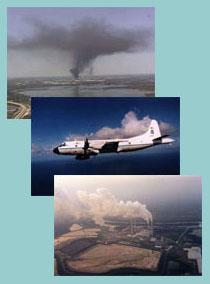
Discovered new factors that cause ozone pollution in Houston, Texas, showing that leaks of reactive gases from the petrochemical refineries prevalent in the region are a much larger factor than previously expected. PAYOFF: These research results have altered the policy approach taken by Texas air quality managers, at a savings of 65,000 jobs and $10 billion by the year 2010 for the state, and are an example of key discoveries needed by NOAA for improved air quality forecasting; and The Aeronomy Lab has used the NOAA P-3 aircraft to investigate the factors that cause poor air quality in different regions of the country. In Texas, leaks from oil refineries were an unexpectedly large factor. In Tennessee, electric power-generating facilities play a major role.
Analyzed past and recent observations to show that tropospheric ozone levels in trans-Pacific air reaching the U.S. West Coast from Asia have increased by about 30 percent near the Earth's surface over the past two decades, demonstrating that a "natural," unperturbed Pacific no longer exists. PAYOFF: The increase in this greenhouse gas influences the radiative forcing of climate and also has implications for regional air quality on the U.S. West Coast.
Research Partnerships
The Aeronomy Laboratory works with the University of Colorado's Cooperative Institute for Research in Environmental Sciences. This Joint Institute was established in 1967 to provide a setting for collaborative research and teaching in the wide-ranging disciplines of the environmental sciences. Over half of the Aeronomy Laboratory's researchers are affiliated with CIRES.
The Aeronomy Laboratory also has research and scientific leadership partnerships with colleagues from other NOAA Research laboratories and other NOAA line offices. For example, the Aeronomy Laboratory is working with the NOAA National Weather Service to develop a new NOAA forecasting service for air quality. The Aeronomy Laboratory also works extensively with external collaborators, such as the cooperative institute AIRMAP in New Hampshire, other federal agencies, private industry and scores of universities and organizations worldwide.
What's Next for the Aeronomy Laboratory?
A continued focus on NOAA's information mission; the Aeronomy Laboratory's research contributes to two of the goals in the new NOAA Strategic Plan: Climate (Goal 2) and Weather and Water (Goal 3). In addition, the Aeronomy Laboratory is serving in major leadership roles within NOAA's program management and planning. Aeronomy Laboratory scientists are leading two of the 39 program areas of NOAA. Aeronomy Laboratory Director, Daniel L. Albritton, is the program manager for the Climate Forcing program of NOAA's Climate Program and research scientist, James Meagher, is the program manager for the Air Quality Program within the Weather and Water goal.
Future Scientific Challenges
Some of the major scientific challenges that the Aeronomy Laboratory will continue to face in the next decade are:
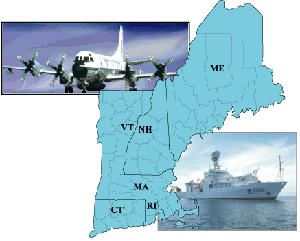
Climate Change — Chemical Composition, Radiation, and Clouds
How well do we understand the role of aerosol processes in controlling radiation, the formation and chemistry of clouds and the alteration of atmospheric chemical composition?
What is the role of intercontinental transport and chemical transformation in regional atmospheres and global climate?
How well do we understand the radiative effects of water vapor and trace gases in the atmosphere?
Regional Air Chemistry
What are the factors (such as nighttime chemistry and sea-to-land transport) that contribute to ozone pollution in New England?
What measurements and diagnostic analyses are needed as the scientific foundation for the emerging NOAA air quality forecasting service?
What regionally-dependent factors influence the formation of atmospheric fine particles and their chemical composition across the chemically-diverse U.S.?
Stratospheric Ozone Layer Recovery
How best can we anticipate, detect and interpret the recovery of the global ozone layer and the Antarctic ozone hole?
How will climate change affect the ultimate recovery state of the ozone layer, and how will changes in the ozone layer affect climate?
What is the "ozone friendliness" and "climate friendliness" of the series of proposed substitutes (e.g., the new very short-lived species) for the now-banned ozone-depleting compounds?
What is the Expectation for the Longer Term?
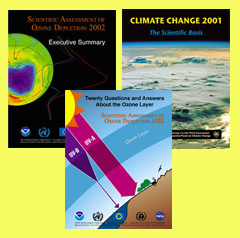
The Aeronomy Lab continues to serve in leadership roles for the international state-of-understanding scientific assessment reports on the topics of climate, ozone-layer depletion, and air quality. In addition, the Aeronomy Lab has led the development of user-friendly documents to answer frequently asked questions about ozone and climate for the public, students, and other non-specialists. Aeronomy Lab scientists are serving as the international cochairs of the scientific panels that will produce the next assessment report on the ozone layer (WMO/UNEP, 2006) and climate (IPCC, 2007).The future is one of more people, ever-increasing standards of living and more numerous technologies. The demands on Earth's resources will undoubtedly go up, rather than down. Therefore, the chemical stresses on the atmosphere will likely increase, driving the value of scientific information about the atmosphere even higher than it is today. As a result, it is foreseeable that the future holds a "bull market" for NOAA's atmospheric information service. For its part, the Aeronomy Laboratory will continue to provide its trademark end-to-end service:
Discovery of new scientific information about atmospheric processes that underlie key environmental issues facing the nation and
Delivery of those discoveries to NOAA's operations and services, as well as to decisionmakers in the national and international arenas.


 The NOAA Aeronomy Laboratory was formed in the 1960s to conduct scientific research on the Earth's atmosphere in an effort to better understand and predict its behavior. That perhaps unfamiliar name — "aeronomy" — has Greek origins and means "the study of the atmospheres of planets." The Aeronomy Laboratory focus is, of course, on Planet Earth. Specifically, the Aeronomy Laboratory's mission has been the study of the chemical, radiative and dynamical processes of the Earth's atmosphere, in order to improve the ability to predict its behavior. Today, the Aeronomy Laboratory's research focuses on the following three atmospheric issues:
The NOAA Aeronomy Laboratory was formed in the 1960s to conduct scientific research on the Earth's atmosphere in an effort to better understand and predict its behavior. That perhaps unfamiliar name — "aeronomy" — has Greek origins and means "the study of the atmospheres of planets." The Aeronomy Laboratory focus is, of course, on Planet Earth. Specifically, the Aeronomy Laboratory's mission has been the study of the chemical, radiative and dynamical processes of the Earth's atmosphere, in order to improve the ability to predict its behavior. Today, the Aeronomy Laboratory's research focuses on the following three atmospheric issues:





